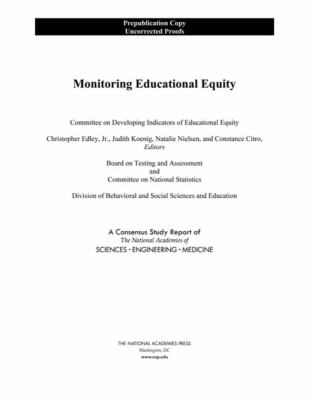
electronic resource
|
Monitoring educational equity
Copies
0 Total copies, 0 Copies are in,
0 Copies are out.
Digital Link
Authors
National Academies of Sciences, Engineering, and Medicine (U.S.). Committee on Developing Indicators of Educational Equity
Edley, Christopher F., 1953-
Koenig, Judith A.
Nielsen, Natalie, 1966-
Citro, Constance F. (Constance Forbes), 1942-
National Academies of Sciences, Engineering, and Medicine (U.S.). Board on Testing and Assessment
National Academies of Sciences, Engineering, and Medicine (U.S.). Committee on National Statistics
National Academies of Sciences, Engineering, and Medicine (U.S.). Division of Behavioral and Social Sciences and Education
National Academies Press (U.S.)
Edley, Christopher F., 1953-
Koenig, Judith A.
Nielsen, Natalie, 1966-
Citro, Constance F. (Constance Forbes), 1942-
National Academies of Sciences, Engineering, and Medicine (U.S.). Board on Testing and Assessment
National Academies of Sciences, Engineering, and Medicine (U.S.). Committee on National Statistics
National Academies of Sciences, Engineering, and Medicine (U.S.). Division of Behavioral and Social Sciences and Education
National Academies Press (U.S.)
Subjects
Language
English







